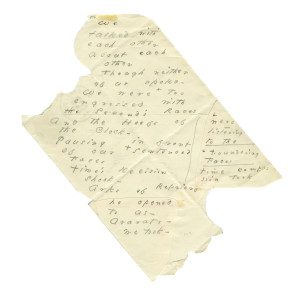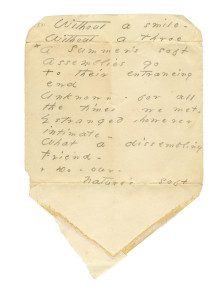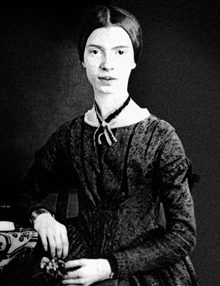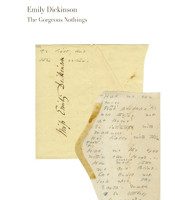Emily Dickinson is our poet of the small. Radically compressed, so complexly faceted that it shifts constantly under pressure, her verse is dedicated to the play between space and presence, blanks, silences, everything and nothing. She’s the voice of the modern.
The Gorgeous Nothings is a simple enough project on the face of it: a full-scale facsimile reproduction of 52 of Emily Dickinson’s “envelope poems,” poems scribbled on flattened envelope scraps. These scraps come from her extensive manuscripts and are printed with essays by Susan Howe and editors Marta Werner and Jen Bervin, with fully diagrammed transcriptions, and with eleven visual indexes that arrange the poems by shape, by address, by column format, by pencilled boundaries and text direction and erasures.
 The title for the project comes from manuscript A821/821a. This is a poem written in three distinct directions across three pieces of paper: “Clogged / only with / Music, like / the Wheels of / Birds / their high / Appoint / ment // of // Afternoon and / the West and / the gorgeous / nothings / which / compose / the / sunset / keep”. And it comes, too, from Dickinson’s own use of the word “nothing,” meaning “everything.”
The title for the project comes from manuscript A821/821a. This is a poem written in three distinct directions across three pieces of paper: “Clogged / only with / Music, like / the Wheels of / Birds / their high / Appoint / ment // of // Afternoon and / the West and / the gorgeous / nothings / which / compose / the / sunset / keep”. And it comes, too, from Dickinson’s own use of the word “nothing,” meaning “everything.”
The Gorgeous Nothings is one of the most ambitious, important literary feats of the year. It’s stunning, revelatory, and it functions as a key text to Dickinson’s oeuvre: seeing it demands a tectonic shift in the way we read her, brings her back to us even more extremely idiosyncratic than we could have guessed.
To understand why The Gorgeous Nothings is so significant, a reminder about how Dickinson comes to us today. Unpublished in her lifetime, her work was left as a massive volume of papers, poems, drafts and letters. Her poems (although many of her letters were also formed as poems) were assembled into one indexed, numbered, canonical text by Thomas Johnson in 1951. This is the format most readers are familiar with.
 The Johnson edition was a monumental service to Dickinson readers and allowed the broadest reading of her work. But it also demanded flattening into only one axis (language, and merely a language that could be typeset at that) something that was also functioning largely in space and time.
The Johnson edition was a monumental service to Dickinson readers and allowed the broadest reading of her work. But it also demanded flattening into only one axis (language, and merely a language that could be typeset at that) something that was also functioning largely in space and time.
This temporal play in space is the only way to read Dickinson: there’s a special correspondence between her language and her tactile form. During her life, Dickinson assembled her poems herself, in her own manner. She bound them in packets that she famously hand-stitched with thread: stitches and characteristic dashes echo across her work, connecting, dividing, letting in light. We knew this already, but as we see in The Gorgeous Nothings there was much more to it than that.
“These envelopes,” write Bervin in the introduction, “have been opened well beyond the point needed to merely extract a letter. … Dickinson is [forcefully] manipulating the form of the page itself.” Dickinson’s radical manipulation of space extends to the form of her text: she leaves enormous blank spaces, divides space into columns, writes in several directions at once, writes upside down, marks the page with crosses and borders and gestural lines. She has a habit of choosing her words on the page, in time: alternates aren’t scratched out but stand side by side, often causing a scan of the poem to splinter as it moves across the page; one poem becomes two, five, nine separate poems. Some pieces are written only on the flap of an envelope; others are written across two or three leaves glued to form the seam of an envelope. Others still are written in unhinged fragments across envelopes painstakingly opened and spread flat like hands, or the wings of birds.
The facing page of every facsimile in The Gorgeous Nothings is a sketched transcription that maps the original in every marking and crease, every odd spacing between letters and words, every variant text size and weight. The effect of reading these scraps as they were written, without the refinement of textual coherence, is impossible to overstate. What would otherwise scan as a nearly illegible stream of single-word lines on a normal page are actually complex verbal gestures and mosaics.
 The most useful metaphor for thinking about Dickinson’s work used to be a domestic analogy, one of interiority: like a labyrinth or a shell, her poems with their rigid outer form opened infinitely inwards, disclosing new vistas endlessly. This was the model for the mythology of Dickinson as a shut-in, one that offered her brilliance only in light of her supposed timidity. It was a metaphor to make her manageable.
The most useful metaphor for thinking about Dickinson’s work used to be a domestic analogy, one of interiority: like a labyrinth or a shell, her poems with their rigid outer form opened infinitely inwards, disclosing new vistas endlessly. This was the model for the mythology of Dickinson as a shut-in, one that offered her brilliance only in light of her supposed timidity. It was a metaphor to make her manageable.
The Gorgeous Nothings gives us a new way to approach Dickinson. Birds, sky, stars, leaves of paper, music, dreams: “Excuse / Emily and / her Atoms / The North / Star is / of small / fabric / but it / implies / much.” The imagery of the Nothings is expansive and far-reaching, dynamic, colossal, and fueled by a brilliance that gives the impression in its haste of being able to burn everything in its wake.
The Dickinson we see in the Nothings–oddly textured, nuanced, bizarre–is a new figure altogether. We can’t rightly call her a poet: her work is a project that’s more far-reaching and radical than poetry. Viewing her oeuvre this way means seeing not only her writing but her archival habits, her self-bound booklets and her pressed flower collection, her letters, her envelopes. Her poesy is more sculptural than anything, and it resists being removed of its various dimensions.
This tendency to live outside a poetic terrain is a fact Dickinson herself declared in poem 567: “I dwell in Possibility — / A fairer House than Prose — / More numerous for windows — / Superior — for Doors.” 567 is usually read as a statement of her domestic tendency, but what it actually does is mark her separation from poetry: her form isn’t prose, but she doesn’t call it poetry, either. It’s Possibility, something with no fixed name, something tenuous which shifts, and flies away.




